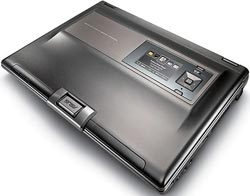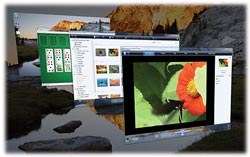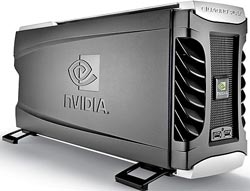Computer in the future?
With breakthroughs like the introduction of fast multi-core processors, raw computer parts are returning with 'sweet revenge'. All have more perfect designs and sizes, more attractive.
The computer of the future will have to improve a lot more competitiveness in order to gain a certain position in your technology heart. But that doesn't mean the PC will "shrink". Currently computers are developing in an increasingly special way with many new forms of creativity, even with traditional desktops. It is the judgment of experienced staff and famous technology experts. But it is not necessarily the picture of the future of computers as you expected.
 Illustration: Harry Capmbell 8-core processor, gigantic hard drive, the prospect of expansion graphics card and large display screen, meeting a variety of possibilities are emerging. While the most challenging factors such as the 20 terabyte drive or multicolored plastic screens are still looking for a way out, the basic, mandatory technologies can grow faster than you originally thought. Like the popular notebook line later, there may be separate mini screens, just to a corner.
Illustration: Harry Capmbell 8-core processor, gigantic hard drive, the prospect of expansion graphics card and large display screen, meeting a variety of possibilities are emerging. While the most challenging factors such as the 20 terabyte drive or multicolored plastic screens are still looking for a way out, the basic, mandatory technologies can grow faster than you originally thought. Like the popular notebook line later, there may be separate mini screens, just to a corner.
PC series: Functional shape
Computers have been developing with basic design components such as the PC Media Center and the Shuttle pint-size system - something that a few years ago never left the lab. From Acer's 20.1-inch 'laptop' (weighing about 17.3 pounds) to Dell's XPS M2010 (a 20.1-inch PC hybrid between laptop and desktop), these 'quirky' systems are decreasing 'weird' of me.
But Dell's chief technology officer, Kevin Ketter, says that although M2010 is interesting browsing exercises, they are not the future. ' Traditional desktops cannot go away overnight .' With potential markets like China, the demand for inexpensive PCs is quite high.
Despite efforts to improve the situation like Intel's Viiv initiative, looking for a standardized PC media component, observers and investors still focus on entertainment PCs. 'The next couple of wireless standards will allow you to access any type of media, anywhere in your home,' says Kevin. You simply won't need an entertainment computer next to the TV like now.
 Source: PC World Steve Kleynhans, vice president of consumer computing at analytics firm Gartner, says that mobile computers will continue to grow in the two main trends today: ultraportables weigh less than 1.8 kg and notebooks replace 15- to 17-inch desktops weighing between 3.5 and 4.5 kg, most of which are plugged in.
Source: PC World Steve Kleynhans, vice president of consumer computing at analytics firm Gartner, says that mobile computers will continue to grow in the two main trends today: ultraportables weigh less than 1.8 kg and notebooks replace 15- to 17-inch desktops weighing between 3.5 and 4.5 kg, most of which are plugged in.
Expected in early 2007, Intel's 4th Centrino laptop platform will be released. People are expecting some new features in this model, such as the NAND flash memory of a few gigabytes of capacity with faster boot times and faster application loading speed.
And don't forget this: Vista's SideShow technology allows laptop manufacturers to integrate a screen on the laptop lid, like an open screen on a sealed box on a mobile phone. If you want to check if there are any e-mails waiting, you don't even need to open the computer. PortalPlayer's Preface technology, expected to be released in the first half of 2007, will partner with SideShow to provide a removable screen or PDA that can be used independently of a notebook.
In the next few years 'quirky' designs will be launched. Jerry Bautista, director of technology management at Intel's Microprocessor Technology Labs, thinks the chips will no longer be built into the machine or form a structure: Imagine what Will it happen when a PDA or mobile phone is built into your sleeve?
A device that dominates all?
Computers have become windows for the digital world over the past 25 years. But the way to access information continues to be developed.
Operating system: Vista . and next?
 Source: PC World What is the official version of Windows Vista expected in early 2007 to change the way the Windows world works?
Source: PC World What is the official version of Windows Vista expected in early 2007 to change the way the Windows world works?
David Siroky, a veteran of Microsoft and a product group manager for Windows, said Vista's advanced features are in three major categories. First, and most useful is graphics. Unlike Windows XP, Vista can use the GPU component in a computer for multiple tasks at the same time. That's key, because Vista's Aero user interface supports strong graphics. Developers (for the first time) can easily use advanced graphics features that support games.
Vista will also appropriately change the area of data storage and information management, Siroky said. ' There is currently no price associated with snapshots. People will have more photos to handle '. XP lacks the functionality to create excitement for the photo software market. But from Vista, Redmond began to grasp this. Users can tag photos with keywords or other metadata. Vista's photo gallery simplifies locating your pictures.
Vista also incorporates a 'reliable monitoring' function, which can show you the system's operating schema over time. If there is a problem with reliability, you can check what happened and reactivate appropriately.
In Linux, with the XGL and Compiz windows, the GUI creates a nice interface, far more than Apple OS X's Aqua interface. In Compiz, the windows are stretched and skewed as if you were adjusting them. . You can view the desktop in a 3D environment by rotating the workspace in a cube style.
Apple OS X - Leopard revision will be released next spring. The sale price of this version will increase, but ensure the stability of the Mac operating system. In this new update, there are some additional components such as automatic backup utility and multiple workspaces. According to research firm Gartner, both Linux and Mac OS will increase user support, while researchers continue to focus on web-based operating systems.
What will be after Vista?
Microsoft CEO Steve Ballmer said the company " never took five years to develop any version of Windows ". If that's true and if the time between the two versions of Windows is so regular, then the next heir to Windows Vista (named Vieena), is expected to be released in 2010 or 2011.
 Source: PC World
Source: PC World
CPU: the more cores, the more pleasant
In just a few years, AMD Athlon X2 and Intel's dual-core CPUs will be crucial because multi-core technology is beginning to grow and is the trend of the future. Jerry Bautista, director of technology management at Intel's microprocessor technology lab, said the company was ready to build the first 8-core test chips. '8 cores will greatly improve application performance. Even thousands of cores are possible. The secret is to find something practical '. Both Intel and AMD plan to introduce four-core chips. Intel's Kentsfield chip is expected to be released later this year. AMD's K8L is in mid-2007. AMD's 4x4 technology with dual-socket systems is used at the same time as both Athlon 64-FX chips will appear in the near future.
The limitation of multi-core technology lies in the software problem. Because basic programs must be redesigned, the parallel process with high ratios can be used. In other words, splitting a task to two or even four cores is quite easy, but separating it into dozens or even hundreds of cores is not easy.
Future technology: Wireless WiMax
Although WiMax (Wi-Fi paired with popular mobile phone characters) has been slow to increase traction, Sprint / Nextel still chooses it as the basic component of the '4G' network.The company plans to release a basic test of download speeds of 4 Megabits per second in 2007 and provide this service to 100 million people by 2008.
Until now, with an 8-core CPU, people are still looking forward to impressive improvements in aggregate programs, from games to search techniques. Simon Hayhurst, director of digital video and audio product management, said that most of Adobe's video applications have elements that can use multiple cores. Because photochemical programs previously used for hyperthreading CPUs also work on multi-core CPUs. ' The beauty of this new method is that we can write the code used in the Hyper-threading CPU and apply it to multi-core CPUs. We can embed it in more CPU cores than today '.
The great jump on the ability to perform a parallel program is also suitable for improving artificial intelligence, according to Bautista ' It will distinguish an AI video of a game from a person doing it ', which forces players to give Out and detect organic ingredients. This smart unit will also be expanded to other applications. ' You can search from thousands of photos, videos, background information, or even financial expressions '.
Of course these implementation improvements will have to be completed with real parameters. Single-core CPUs have faced the problem of increased power consumption and severe heat loss, significantly reducing the life of the device structure. The smaller, the more efficient the cores work, and will continue to provide better overall power profiles than single megachips. This is a happy signal for notebooks, which face this problem more seriously
desktop.
See related articles :
Future of battle for operating systems AMD's technical director, Phi Hester, stresses that mobility will be a major trend for companies over the next few years, and ATI graphics will be key in strategy. this. ' In the 80s of the last century, the 286 and 386 were co-dividing mathematical processors. Newly integrated immediately into the CPU. This also happens with 3D graphics, during Vista's next time . ' According to Hester, there will be an upgraded power management program, which can tell us recently whether the size division for a PDA is capable of producing excellent computer graphics cables.
If you want to have powerful computers, you must upgrade the parts in the main board. Memory bandwidth must expand greatly to keep up with the CPU, hard disk I / O must also control the data transmission faster. If you want a more realistic online game program, ' even your broadband connection needs to change ,' Bautista said.
What about Moore's Law? The company said the number of transistors in a chip almost doubled after January 18 (along with the source of the CPU processing program). ' Transistors will still exist and function well '. Parallel processors, splitting a job onto multiple cores will become more and more efficient. ' The more the core, the smaller it is, the easier it is to build and there will be no stopping point in this regard because the production programs are still shrinking. All stars will shine in the sky right away, 'Bautista continued.
LCD: Larger, brighter, worth buying
 Source: PC World By the end of the year, the widescreen will account for 10 to 12% of the desktop market, and may rise to 20% by the end of next year, Chris Connery - the vice president of market research for the firm. DisplaySearch said.
Source: PC World By the end of the year, the widescreen will account for 10 to 12% of the desktop market, and may rise to 20% by the end of next year, Chris Connery - the vice president of market research for the firm. DisplaySearch said.
Another strong trend is that LCD screens will become bigger, brighter and cheaper. Rhoda Alexander, director of screen research at iSuppli, said that in 2005 only 78% of screens were 17 inches and smaller. But by 2010, it will be less than 20%. Resolution demonstrates the development speed of the screen. Currently only 4% of screens have a higher resolution than SXGA (1280x1024), but Alexander said that by 1010 this ratio will increase to 23%.
25-inch screens and more will also become popular, LED lights in the machine help screen brighter, more realistic color display.
What about quantum-functional monitor monitors such as structural LED (OLED) and silicon liquid crystals (LCoS)? Maybe they will be neatly placed in a certain corner. OLEDs will be as small as MP3 players and cameras. LCoS will be just like a headlight. But LCD screens are really worth looking at both the value and price expected at least 5 years later to appear.
Flexible screens can bend and curl, as well as electronic ink products will also appear on the market, starting from areas like grocery stores that regulate installation prices and update easily.
The contact screen will also be more popular. NYU researcher Jeff Han proved astonishingly improved on this technology earlier this year. It is a multi-touch monitor, local base signal interface.
Graphics: not just for people playing games
 nVidia Quadro Plex ( Source: PC World ) The desire to have powerful graphics devices is constantly increasing. As director of the nVidia Scientific Research Center, David Kirk said: ' We have been trying our best to do what we can for years .'
nVidia Quadro Plex ( Source: PC World ) The desire to have powerful graphics devices is constantly increasing. As director of the nVidia Scientific Research Center, David Kirk said: ' We have been trying our best to do what we can for years .'
GPU manufacturers are busy preparing for DirectX 10 and upgrading the 8X executable program to 9X. It is expected that nVidia and ATI will transition to GPUs using unified polished structure components. These are common purpose pipes like pixel expression, geometry, or even physical code. Future GPUs are getting more and more pipeline, allowing for some amazing real effects. Dedicated physical cards (like the Ageia PhysX accelerator) in the regular graphics table can also be more prevalent. Future technology: RAM Bottleneck
The average execution speed of the CPU increases by 50% annually, but the access speed of RAM has not changed, so it is not catching up.Magnetoresistive RAM (or MRAM) is a potential solution: The promising memory in the future will be very stable when using magnetic technology instead of the electronic storage component as today. Freescale, IBM, and Research Research NEC is gradually becoming a reality.
The market will quickly decide whether the GPU or a subprocessor is the best way to control physical programs.
Products like the nVidia Quadro Plex may be a signal to the market. The additional $ 17,000 device is an extended graphics system that can perform 80 billion calculations in a second, about 10 times more than today's top powerful PC graphics card. Experts believe that conventional cards will only consume about 200W of electricity and require extended components.
Another energy-efficient graphics technology - the general purpose GPU, uses the capabilities of an optional graphics card in a non-gaming environment. Adobe has been using GPGPU for video conversion since 1995.
Terabyte and scalability
 Seagate's 750GB Barracuda ( Source: PC World ) Hitachi's experienced expert, HP Healy, says that if you still follow the current trend, by 2025 a 3.5-inch standard hard drive can hold 20 terabytes of data. .
Seagate's 750GB Barracuda ( Source: PC World ) Hitachi's experienced expert, HP Healy, says that if you still follow the current trend, by 2025 a 3.5-inch standard hard drive can hold 20 terabytes of data. .
Orthogonal magnetic recording technology (PMR) will beat traditional vertical magnetic recording technology. With this technology, hard drives encapsulate a lot of data in a smaller physical area. The first hard drive using PMR technology appeared on the market last year was Seagate.
Heat-assisted magnetic recording technology (HAMR) allows the creation of heavier bit support discs to appear in the next decade. Even later there was disk media, bypassing the 'uniform' layer that was especially preferred for 'peninsula' materials that could not be physically contacted.
The future of optical storage is the least certain. The battle between Blu-ray Disc and HD DVD, the two conflicting blue laser formats and always competing, has yet to end. ' As long as these two solutions are still fighting, the critical mass will never be established; and prices remain high , 'Garter's Steve Kleynhans said. ' You need a single standard to control elasticity and normal width approval .'
Meanwhile, potential upgrades to flash media can be made in the extremely heavy-duty detection area, currently developed by Seagate. This technique is based on microscopic borrowed technology, and can fit 10GB of data into a drive the size of an SD Card.
You should read it
- Razer launched a cheaper external GPU, supporting macOS
- Is Core i5 laptop price Core i3 worth buying?
- Acer introduced four pre-installed Vista laptops
- Compaq Presario CQ42 adds new lines
- Samsung launched RF series and laptops for entertainment
- iPad, the next iPhone version handles graphics 4 times faster
- The first popular laptop uses a 32-core graphics card
- Macbook Pro officially up Core i5, i7
May be interested
- Embed Sim (eSIM) will be the new trend in the future?
 embed sim (esim) will be the new trend in the future? let's tipsmake.com find out in the article below!
embed sim (esim) will be the new trend in the future? let's tipsmake.com find out in the article below! - Quantum computer - 18 billion billion times faster, is it realistic?
 according to a physicist at the university of utah, the future is likely to have a new type of computer - quantum computer. he took the first step in his plan to create that computer.
according to a physicist at the university of utah, the future is likely to have a new type of computer - quantum computer. he took the first step in his plan to create that computer. - Lapse: A Forgotten Future tips for extending tenure
 lapse: a forgotten future tips, useful tips for playing lapse: a forgotten future help gamers rule the country for years.
lapse: a forgotten future tips, useful tips for playing lapse: a forgotten future help gamers rule the country for years. - 3 future prospects that businesses need to know
 when the global economy continues to have unpredictable movements, it is important for businesses to anticipate future prospects to quickly adjust their strategies accordingly.
when the global economy continues to have unpredictable movements, it is important for businesses to anticipate future prospects to quickly adjust their strategies accordingly. - Who would have expected these strange creatures to live with humans on Earth in the future
 scientists have researched and made a list of species that might be 'heavenly' with us for the next few thousand years. surely you will not be surprised to see their strange shapes.
scientists have researched and made a list of species that might be 'heavenly' with us for the next few thousand years. surely you will not be surprised to see their strange shapes. - After netbooks are net-top
 some computer makers said the next few months will market computers with the name 'net-top,' a cheap version of the desktop computer.
some computer makers said the next few months will market computers with the name 'net-top,' a cheap version of the desktop computer. - 26 photos of life filled with future Japanese technology
 the japanese people are and will have a life filled with future technology, taken care of both materially and spiritually. to visualize some part of life, please take a look at 26 photos below.
the japanese people are and will have a life filled with future technology, taken care of both materially and spiritually. to visualize some part of life, please take a look at 26 photos below. - Future viruses can overcome all sensors?
 researchers at the university of wisconsin have come up with a study that suggests that some future viruses may be able to overcome the network security warnings sans internet storm center and symantec have been proud of for a long time.
researchers at the university of wisconsin have come up with a study that suggests that some future viruses may be able to overcome the network security warnings sans internet storm center and symantec have been proud of for a long time. - The man 'sees' the future makes medicine 'bundle'
 not a character in a hollywood fantasy movie, a french man who can predict his future makes science impossible to decipher.
not a character in a hollywood fantasy movie, a french man who can predict his future makes science impossible to decipher. - Future battle of the operating system
 choosing an appropriate operating system is a very important factor. but in the future you will no longer have to worry about this. the rapid acceleration of virtualization technology allows you to run multiple operating systems on the same computer
choosing an appropriate operating system is a very important factor. but in the future you will no longer have to worry about this. the rapid acceleration of virtualization technology allows you to run multiple operating systems on the same computer










 The virtual network world of the future
The virtual network world of the future Glossy Windows Media Player
Glossy Windows Media Player Learn more about Yahoo Messenger
Learn more about Yahoo Messenger 8 points of interest when choosing to buy PDA
8 points of interest when choosing to buy PDA Printing solutions - Dedicated or versatile
Printing solutions - Dedicated or versatile